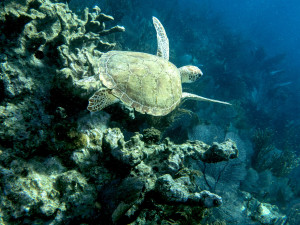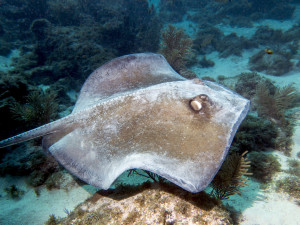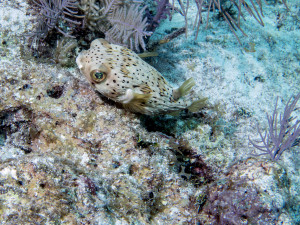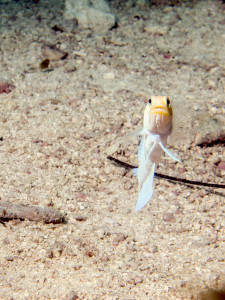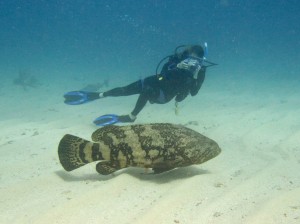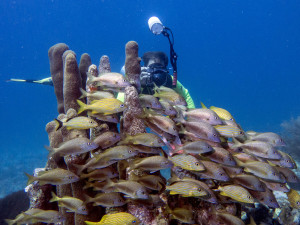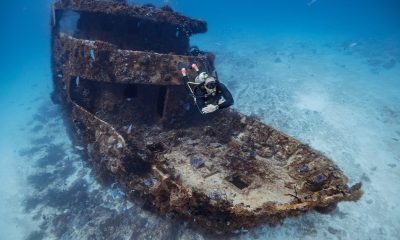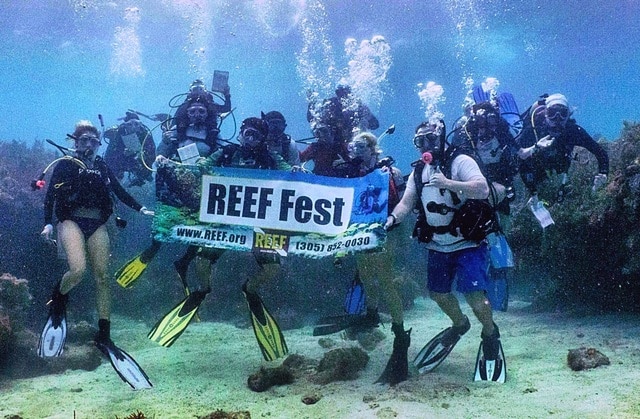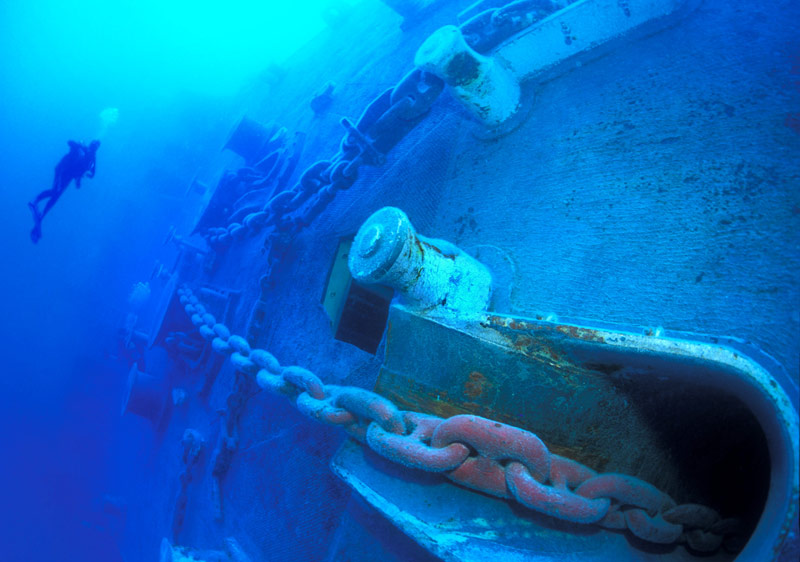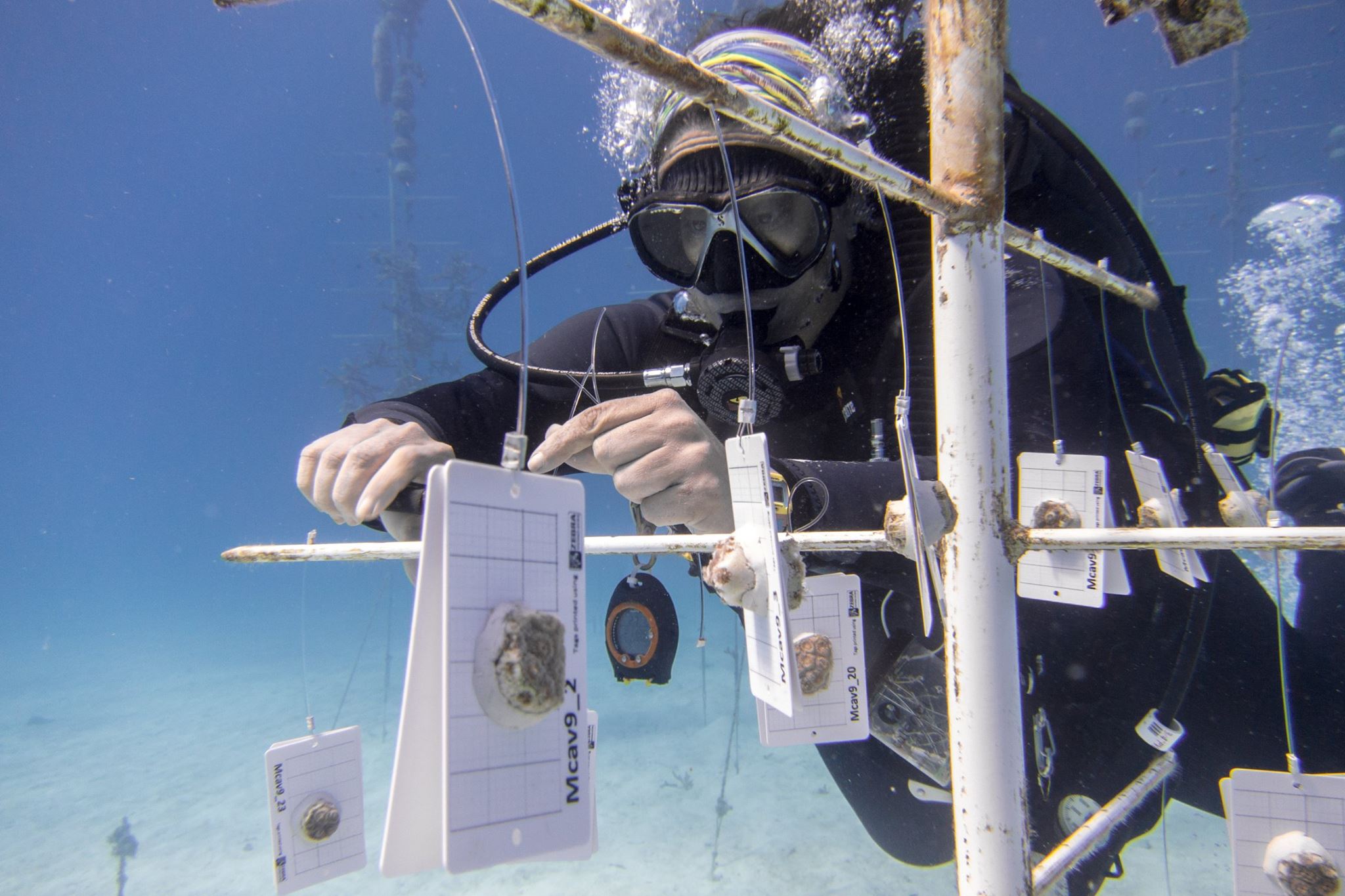Travel Stories
Key Largo – Scuba, Sunsets, and More
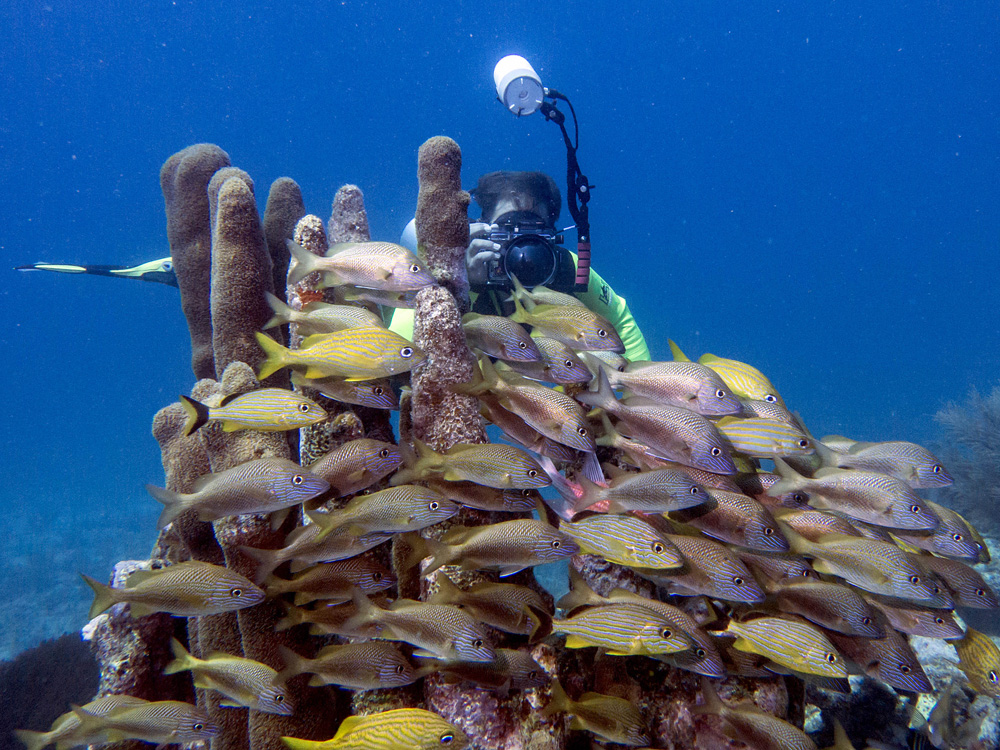
Photos by Hugh Hudson
Shallow reefs, deep and shallow wrecks, sanctuary protected marine life and year round diving. Okay, no shore diving to speak of, but there are plenty of good reasons that Key Largo is a popular destination for divers from across the country and around the world. It is ideal for beginners with reefs that are 30-40 feet in depth and advanced and technical divers can explore deeper wrecks like the 510-foot USS Spiegel Grove to the extent that their training allows.
Key Largo – known outside the dive community for the classic Humphrey Bogart and Lauren Bacall film (not to mention the later song by Bertie Higgins) – is the first populated town as you leave the Florida mainland peninsula and make your way south to Key West and the southernmost point in the United States. Key Largo is also home to John Pennekamp Coral Reef State Park, the first underwater park established in the U.S., and the iconic, much-photographed Christ of the Abyss statue sits in only 25 feet of water at a site called Dry Rocks. It is, however, the sheer multitude of dive sites and dive operations that makes Key Largo a favored spot. If you want extra details about the geological underpinning of Key Largo’s diving, check out http://www.fla-keys.com/keylargo/keylargodivewonderland.cfm, but for the sake of this post, let’s focus on the more than 50 regularly visited sites that are available within a 40-minute boat ride. With the third largest barrier reef in the world, the sites are a mix of natural reefs and numerous genuine wrecks in scattered debris fields as well as ships deployed as artificial reefs. The older, genuine wrecks have little structure remaining as is to be expected in warm salt water, but they provide great habitats for creatures large and small.
While you do not, in general, have the profusion of colorful corals and sponges of many places in the Caribbean, abundant and healthy marine life is to be seen within moments of slipping underwater. “The usual suspects” will be multiple varieties of snapper, parrotfish (including the beautiful midnight variety), barracuda, angelfish, butterfly fish, trumpetfish, grunts, hog fish, file fish, lizardfish, squirrelfish, trunkfish, damselfish, eels, southern stingrays, turtles, nurse sharks, groupers, (including goliaths), sea cucumbers, shrimp, and lobsters. A hundred other species could be named and seeing dolphins on the ride to or from the sites is not unusual, nor is the appearance of manatees in the canals. Snapper Ledge gets its name from the fact that schools of fish are often so dense that they obscure sections of the reef. For those who happen to be in the water at the right time and location, there are occasional visits from a cruising hammerhead, a manta ray, or even a whale shark, and technical divers who go to the really deep wrecks such as the Northern Lights will often encounter bull sharks.
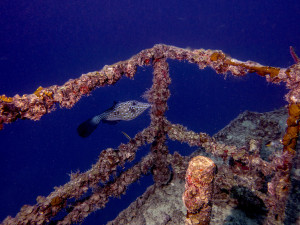
The growth on the USS Spiegel Grove, the 510-foot ship off Key Largo can be seen as this scrawled file fish swims by
Although the reliability of Key Largo weather can be impacted by either storms or systems that bring in high winds and the water temperature does drop to around 70 degrees in the winter months, charters go out every day of the year, conditions permitting. Granted, there is an element of amusement when locals hesitate to dive with air and in water with a temperature in the low 70s, while visitors escaping snow and ice are happy with the balmy weather. However, when it is chilly, appropriate protection with layering is in order for the boat ride. March through mid-May usually brings air temperature in the 80s and the water moving up to 75+ degrees, and by the end of May through late September, hot is the word. Hats, sunscreen, and hydration are all important. October is a toss-up with heat that usually comes down in November.
Visibility and currents on the deep wrecks will often vary more than on the reefs and a normal day for the reefs will be 50-60 feet of visibility and mild current, with frequent days of 70-100 feet. For those who appreciate technology, there is a NOAA tower mounted at Molasses Reef and you can access it for the latest conditions. (http://www.ndbc.noaa.gov/station_page.php?station=mlrf1)
Choosing among approximately two dozen dive centers in Key Largo might be the difficult part, and that very much becomes a personal choice. Some shops specialize in a maximum of six passengers, others have the 14 passenger boats, and several operators have the large boats that carry between 30 and 42 passengers. The larger operators may have two different size boats that can be a factor if traveling with a group of mixed levels. Many of the dive shops have their own dock and others have a storefront with their boat at a nearby marina. There are resorts that have the complete package of lodging, on-site dive center, and restaurant. Individual dive centers may well have discount arrangements with hotel and restaurants, so check that when you either call a dive shop or look at a web site.
There are three particular things to know about dive centers in Key Largo. The first is a regional Coast Guard requirement for a mate to remain on board with the captain any time there are more than six customers. This means that unlike in most other places, dive centers, in general, do not put a dive master into the water with divers because that would mean having two dive masters per trip which would then increase the per dive cost. Some dive centers have chosen to either absorb that cost or pass it on, but if you want a guide, you will need to ask the direct question. Hiring a guide will be an additional charge and also leads to the next item. The scuba community standard policy is that if a diver has not been in the water for a year, the shop could very well require the diver to have a guide for the first trip and this will be an additional cost. If it has been two or more years since last diving there may be a need for a refresher course. The third item is for those who wish to dive the deep wrecks of the Bibb, Duane, and USS Spiegel Grove. These are advanced dives with the community standard of showing proof of advanced certification, documented wreck and deep experience, or to be in the company of a guide in order to do the dive. Even though you can dive a small part of the Spiegel at approximately 65 feet, most of the ship is at 80 feet or below and current can be challenging. Descending onto the 510-foot long ship is an awesome experience, but it is not for novices. While the Bibb and Duane are not as large, they are older artificial reefs with significant marine growth.
For planning purposes, Key Largo is a little over an hour from Miami International Airport during non-peak traffic time and Fort Lauderdale Airport is twenty minutes further north. The Florida Turnpike (toll road) is the most direct route and it ends in Florida City/Homestead as you pick up Highway 1 South, also known as the Overseas Highway. This is a two-lane road with only a couple of passing zones, so relax and watch for egrets, ospreys, herons, and other water fowl along the way.
Once you arrive in Key Largo, local directions tend to be given as Ocean Side or Bay Side and by Mile Marker rather than using street names. As you drive south, the Atlantic Ocean is to your left (east) and Florida Bay to your right (west). The sunset restaurants are bay-side, but the dive sites are ocean-side and therefore about ten minutes less of a boat ride if the dive center you choose is located ocean-side.
If there is one thing that rivals the number of dive centers in Key Largo, that would be restaurants and bars. As you can imagine, there is a lot of outdoor dining, and casual is most assuredly the preferred attire. Claims to have the best conch fritters and key lime pie abound and while American cuisine and fresh seafood are what you find the most, you can get Italian, Mexican, Thai, and one or two others. Hog fish and lion fish might be on the menu – both are firm white fish that you won’t find offered in too many places and both are highly recommended.
For your non-diving days, or if you have non-divers with you, other watersports are plentiful and the Wild Bird Center is a fun place to visit. A short trip south will take you to the Theater of the Sea or to the History of Diving Museum with its rich displays of 4,000 years of man’s attempts to temporarily exist beneath the waves. A short trip back north to Florida City and Homestead puts you at the doorstep of the Everglades and Biscayne National Parks, the Coral Castle, and the Monkey Jungle. In fact, if hotel rooms are hard to find in Key Largo, Florida City and Homestead provide an easy alternative. If you want to take the Overseas Highway all the way south passing through Islamorada, Marathon, over the much-filmed Seven Mile Bridge and arriving in Key West, plan a full two hours. The scenic two-lane road has few places to pass.
Warm breezes, palm fronds rustling, tropical blossoms, parrots that streak overhead top side, with teeming marine life below. This is the Key Largo that you may not have visited for a while, or perhaps have never come to. It is a slice of paradise right here in the United States, and for those 300-plus days a year when Mother Nature isn’t being capricious, a healthy underwater world with the tiniest shrimp up to 600-pound goliath groupers awaits you.
An excellent web site for more information is http://www.fla-keys.com/keylargo
Blogs
Alonissos: The complete diving destination (Part 1)

In June we were incredibly fortunate to be invited to dive in Alonissos, a small Greek Island in the Sporades island chain located in the North Aegean Sea. While I have long been a big fan of the Greek Islands as a great holiday destination, I had not had the opportunity to do any diving on previous visits and Mike and I were extremely excited to see what Alonissos had to offer both above and below the surface!

The Sporades are easily accessible via the airport in Skiathos (the first island in the chain), which is served by Jet2 flights from all major UK airports from May through October. Numerous ferries and charter boats make island hopping from Skiathos Town a breeze. After an hour boat ride, the picturesque port of Patitiri was a wonderful introduction to Alonissos, where we were met by our gracious hosts Kostas of Albedo Travel and Dias of Alonissos Triton Dive Center. Mike and I were delighted to be staying at the Paradise Hotel, aptly named for its stunning views over the sea and great location for walking to the waterfront.

Alonissos is beautifully situated in the National Marine Park of Alonissos and the Northern Sporades, the largest marine protected area in Europe. The surrounding seas offer fabulous marine life, including incredibly rare species such as the Mediterranean monk seal. They boast deep walls covered in gorgonians and sponges, stunning topography with caverns, swimthroughs and pinnacles, and the first accessible ancient shipwreck from 500BC!

In locations where historical sites have been reported, the waters are largely restricted, but with collaboration between government, underwater archeologists and dive centres, incredible underwater museums are being created for a truly unique diving experience. Alonissos is home to the first of these, the Ancient Shipwreck of Peristera Accessible Underwater Archeological Site. The chance to dive into history (along with reports of healthy reef life and amazing underwater topography) meant Mike and I were keen to get in the water.

Our introduction to the diving around Alonissos was at the Agios Georgios Pinnacles, in the channel between Alonissos and Skopelos. This fantastic site was named “The Chimney,’ and proved to have a huge amount to see. We got to a decent depth here (over 25m), and marvelled at a colourful reef wall with a wonderful swim through whose rocky walls were absolutely covered with life. As well as brilliant topography there was no shortage of macro life here. We saw numerous nudibranchs, five different species in total. The second dive at Mourtias reef nearby was a shallower dive along a nice wall with lots of crevices. Several moray eels and grouper called this site home. We enjoyed looking in the crevices for lobster and smaller benthic life, such as cup corals and tunicates.

Our itinerary allowed us two dives a day with afternoons left to explore the island with our hire car and evenings to enjoy the famous Greek hospitality. This proved to be a lovely mix of in-water and land based diversions.

The next days diving to the Gorgonian Gardens and Triton’s Cave was to be even better! These two stunning sites are nothing short of fabulous. The Gorgonian Gardens was a deep wall near to the Agios Georgios islands. The ever-present currents in this deep channel meant that the sea life was amazing … the namesake Gorgonian sea fans dotted the wall at a depth of 30 to 50 meters, getting ever larger the deeper we went. Above 30m was by no means less beautiful, with sponges, corals, scorpionfish, moray eels and some rare and colourful nudibranchs.

The second shallower dive of the day was to Triton’s Cave or the Cavern of Skopelos, on the east side of that island. The spectacular rock formations had wild striations both above and below the water making a truly epic topography. The cavern entrance was at 14m, and big enough for a buddy pair, winding up to 6m and passing two beautiful windows out into the blue. Emerging from the cavern, the light at the shallower depths and the incredible rock formations made for a fantastic gentle swimming safety stop and we all surfaced by the boat with massive grins.

Check out our next blog :Alonissos: The complete diving destination (Part 2)” to hear about our amazing dive on the 2500 year old Peristera Wreck!
Thanks to:
Alonissos Triton Dive Center https://bestdivingingreece.com/
Albedo Travel https://alonissosholidays.com/activities/
Paradise Hotel https://paradise-hotel.gr/
Alonissos Municipality https://alonissos.gr/en/
Blogs
Mamma Mia! Diving Skopelos (Part 2)

Our second days dive itinerary was to the famous Christoforos wreck! This is arguably the best dive in Skopelos and though only open to divers with deep diving experience, this 83m long wreck is well worth the visit.
The Christoforos sits in 43 meters of water with the deck at 32 to 35 meters. A 30m dive can give an impressive view of the wreck, though such a large wreck needs a few dives to truly do it justice. Given its ideal location just a 2 minute boat ride from the dive centre dock it is an excellent first dive of the day. The sheltered site is also diveable in all but the absolute worst weather so although deep, the water is usually clear with little to no current making it a very pleasant dive. The site is superb for technical diving and a great training site for the Tec 40 and 45 programs, offered by Skopelos Dive Center.

The Christoforos wreck was originally a collier ship built in 1950 at Grangemouth shipyard under the name “Thomas Hardie”. In 1976 she joined the Greek merchant fleet as “Christoforos”. On the 2nd of October 1983 the Christoforos was carrying 2600 tonnes of cement from Volos to Piraeus Port. During the voyage the weather turned, resulting in the ship developing a 7 degree list, whereby she changed course for safe anchorage at Panormos, Skopelos. The ship reached Panormos at 16:00 with a list of 17 degrees and water ingress to No. 1 hull. Though attempts were made to right the vessel, the crew were ordered to abandon ship at 22:00. The captain, lieutenant and the quartermaster remained to try and save the ship, but had to abandon the attempt themselves and the Christoforos finally sank at 05:30 on 3rd October 1983. She now sits upright in 43 meters of water less than 200m from shore in Panormos.

Diving has only been allowed here since 2018, so the wreck is very well preserved and a real treat to dive. Permission to dive here was granted by the authorities after lots of incredibly hard work by the Skopelos Dive Center staff. Having a fantastic wreck in such an amazing location and in excellent condition is a real privilege.

Of all the sites in Skopelos this was the site Mike and I were most keen to experience. Having kitted up and zipped across the bay to the mooring, we left the surface and followed the descent line until the wreck emerged spectacularly from the blue at 15m. She is a big and beautiful wreck, sitting as though calmly continuing her journey along the seabed. With most of her original features still intact there were points of interest everywhere, including the anchors, winches, ships telegraphs, the wheel and RDF antenna.

We found that aquatic life had colonised the ship, with schools of fish, electric blue nudibranchs, a large moray eel and the resident scorpionfish lurking inside the bridge. The Christoforos was truly a stunning wreck and despite maximising our time at depth we eventually had to say our goodbyes and begin the slow and steady return to the surface.

After a superb morning dive we had the afternoon to do a little sightseeing of the island, with a trip to the church of Agios Ioannis Kastri made famous by the blockbuster movie “Mamma Mia!”. Mike and I spent a happy afternoon pootling around in our little hire car before meeting up with Lina from Skopelos Dive Center. An underwater archeologist as well as a dive professional, Lina had offered to show us a rather special attraction, the Christoforos shipwreck Digital Spot public information and awareness centre.

A fantastic initiative made possible from the collaboration of the government and hard work of the staff at Skopelos Dive Center is the “Digital Spot” in Agnontas port. This information center has a number of displays on the history of the Christoforos wreck, the process by which the wreck was allowed to be opened to the public for diving tourism, other sites of historical interest in the area, a video of the wreck and the best bit, a virtual reality dry dive experience! The beauty of the VR system is that non diving members of the family can see what you have seen on the wreck, or you can see areas that you may not have explored during the dive due to time or depth limitations. It was a truly immersive experience and a great addition to the dive itself.

After a wonderful day we celebrated our last evening on the island with an exquisite meal in Skopelos Town with fabulous views over the town and bay, washed down with the excellent local wine. The lamb with lemon and potatoes was a meal which I could happily eat every day for the rest of my life!

Skopelos is an island that truly has it all. The diving is excellent, the landscape is beautiful with plenty of non diving activities, the locals friendly and the food and drink superb. Given how accessible it is as a holiday destination it has avoided becoming overcrowded and even in peak season offers a fun yet relaxing atmosphere. We highly recommend giving Skopelos a visit. We will certainly be back again!
Thanks to:
Municipality of Skopelos (https://skopelos.com/)
Skopelos Dive Center (https://sporadesdiving.gr/)
Ionia Hotel (https://www.ioniahotel.gr/en)
Dolphin of Skopelos (https://dolphinofskopelos.com/)
Ta Kymata restaurant (@takymata)
The Muses restaurant (https://www.facebook.com/TheMussesMousses/)
Aktaiov resturant (https://skopelos.com/listings/aktaion-taverna/)
-

 Blogs2 months ago
Blogs2 months agoDiving With… Nico, Ocean Earth Travels, Indonesia
-

 News1 month ago
News1 month agoMurex Bangka Announce New Oceanfront Cottages & Beachfront Dining
-

 Blogs2 months ago
Blogs2 months agoA new idea in freediving from RAID
-

 Marine Life & Conservation1 month ago
Marine Life & Conservation1 month agoIceland issue millionaire whale hunter a licence to murder 128 vulnerable fin whales
-

 Marine Life & Conservation2 months ago
Marine Life & Conservation2 months agoThe Shark Trust Great Shark Snapshot is back
-

 News3 months ago
News3 months agoCharting New Waters; NovoScuba Goes Global with the Launch of their Revolutionary Dive Training Agency!
-

 Gear News1 month ago
Gear News1 month agoNew Suunto Ocean – a dive computer and GPS sports watch in one for adventures below and above the surface
-

 Marine Life & Conservation Blogs2 months ago
Marine Life & Conservation Blogs2 months agoBook Review: Plankton


